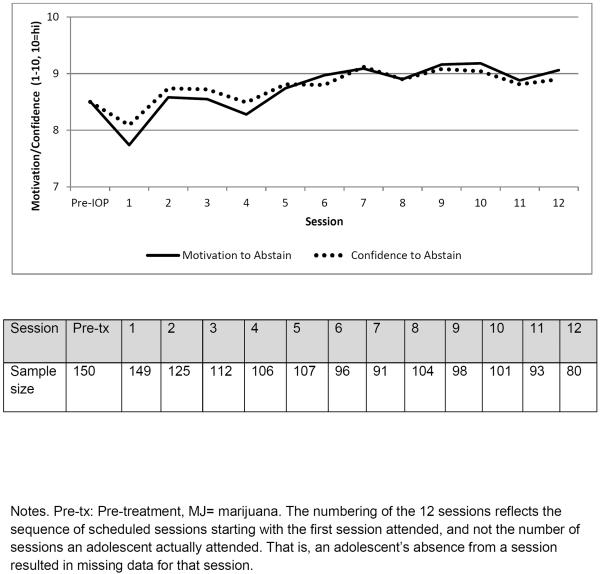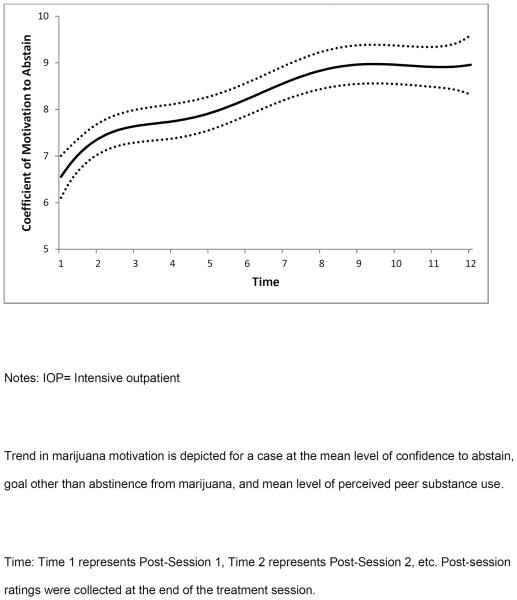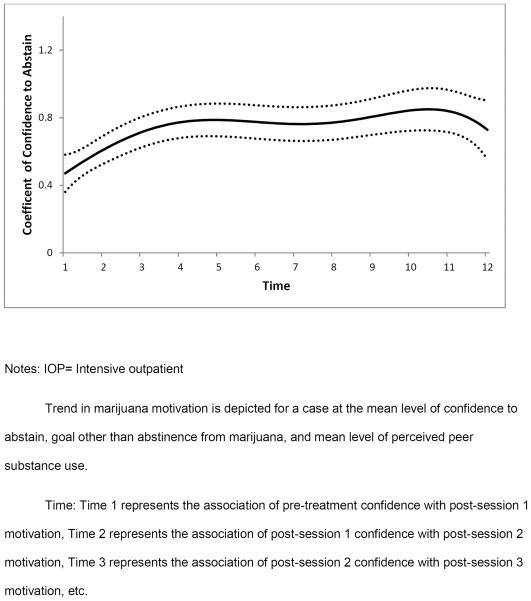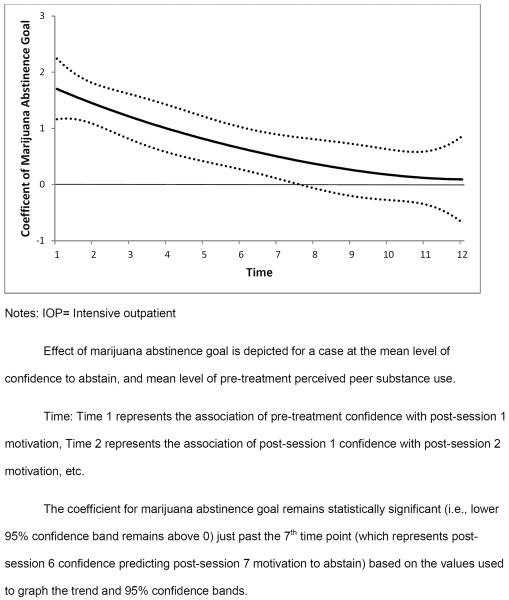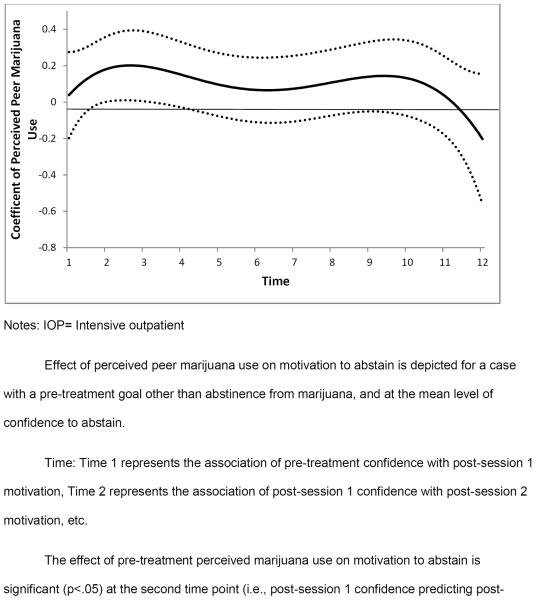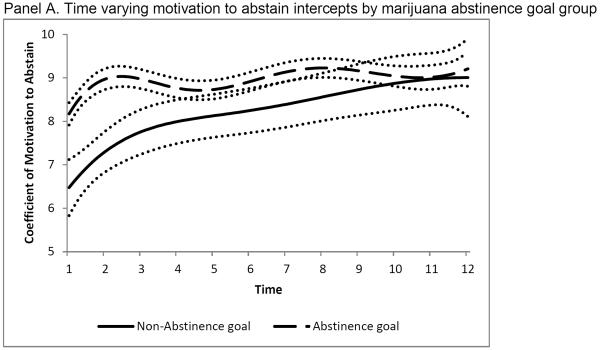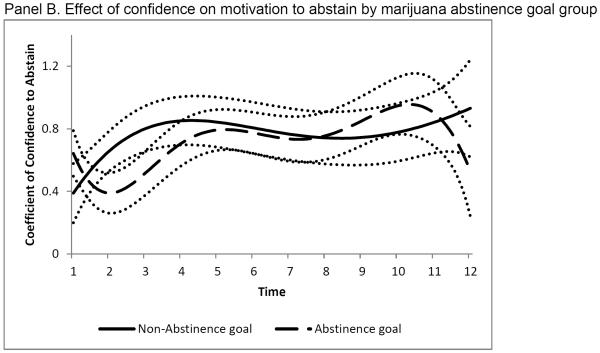Abstract
Introduction
An important goal of addictions treatment is to develop a positive association between high levels of confidence and motivation to abstain from substance use. This study modeled the time-varying association between confidence and motivation to abstain from marijuana use among youth in treatment, and the time-varying effect of pre-treatment covariates (marijuana abstinence goal and perceived peer marijuana use) on motivation to abstain.
Method
150 adolescents (75% male, 83% White) in community-based intensive outpatient treatment in Pennsylvania completed a pre-treatment assessment of abstinence goal, perceived peer marijuana use, and motivation and confidence to abstain from marijuana. Ratings of motivation and confidence to abstain also were collected after each session. A Time-Varying Effect Model (TVEM) was used to characterize changes in the association between confidence and motivation to abstain (lagged), and included covariates representing pre-treatment abstinence goal and perceived peer marijuana use.
Results
Confidence and motivation to abstain from marijuana generally increased during treatment. The association between confidence and motivation strengthened across sessions 1-4, and was maintained through later sessions. Pre-treatment abstinence goal had an early time-limited effect (through session 6) on motivation to abstain. Pre-treatment perception of peer marijuana use had a significant effect on motivation to abstain only at session 2.
Conclusions
Early treatment sessions represent a critical period during which the association between confidence and motivation to abstain generally increased. The time-limited effects of pre-treatment characteristics suggest the importance of early sessions in addressing abstinence goal and peer substance use that may impact motivation to abstain from marijuana.
Keywords: adolescent, marijuana use, treatment, motivation to abstain, self-efficacy, Time-Varying Effect Model
1. Introduction
Two key addictions treatment constructs, self-efficacy and motivation to abstain, independently predict treatment outcome in adolescents [1, 2] and adults [3–8]. Self-efficacy, or confidence, to abstain refers to an individual's belief in his/her ability to abstain, whereas motivation refers to the individual's desire or will to abstain from substance use. Confidence and motivation to abstain may be associated [9, 10], and some consider confidence to be a core component of motivation. As defined here, however, confidence and motivation represent distinct, yet correlated constructs. Little is known about how the association between confidence and motivation to abstain changes from session-to-session. In particular, early treatment sessions may be critical to increasing confidence and motivation to abstain [2, 11], and strengthening the positive association between high levels of both constructs. An increase in the strength of the positive association between high levels of confidence and motivation to abstain might reflect a process whereby high levels of both mutually reinforce one another to support abstinence from substance use.
Prior research examining changes in motivation to abstain among treated adolescents found that motivation tended to decline, on average, over 6-month follow-up [9]. By comparison, adolescents' perceived difficulty to abstain was, on average, rated as moderate and relatively stable over follow-up [9]. Importantly, the negative association between motivation and perceived difficulty to abstain increased over follow-up, such that greater perceived difficulty to abstain became more strongly associated with lower motivation to abstain, and lower motivation to abstain prospectively predicted greater frequency of marijuana use [9]. Whereas perceived difficulty to abstain, which has been found to be negatively correlated with confidence to abstain [12], may be salient over follow-up posttreatment, building confidence to abstain is often a focus during treatment. An important gap to be addressed by this study involves characterizing changes in motivation and confidence to abstain from session-to-session, and examining how the strength of their association may change in order to identify turning points in treatment.
Among youth entering substance use treatment, pre-treatment characteristics, such as choice of an abstinence goal and perceived peer marijuana use, may influence both confidence and motivation to abstain. In particular, a pre-treatment choice of abstinence goal may be associated with one's confidence in achieving the goal [10] and motivation for behavior change [13]. For example, selecting a pre-treatment goal other than abstinence (e.g., “moderate” use of marijuana) may be associated with low pre-treatment confidence in achieving an abstinence goal, whereas selecting a pre-treatment abstinence goal may be associated with high pre-treatment confidence to achieve abstinence [7]. Pre-treatment abstinence goal choice also might affect motivation, such that setting an abstinence goal can stimulate efforts to achieve the desired outcome [14]. Little is known about how abstinence goal, assessed prior to starting treatment, may be related to confidence and motivation to abstain during treatment.
Perceived social norms regarding substance use also may influence confidence and motivation to abstain [15]. For example, among adolescent heavy marijuana users, confidence in one's ability to avoid marijuana use mediated the association between perceived peer use and frequency of marijuana use [16]. Further, greater confidence in the ability to reduce use and lower substance use in an individual's personal network independently predicted better 1-year treatment outcomes [17]. These findings suggest that greater perceived peer marijuana use is associated with lower confidence and motivation to abstain. However, the extent to which perceived peer marijuana use has a stable effect on confidence and motivation to abstain during treatment, or whether increasing time in treatment may reduce the effect of perceived peer marijuana use on confidence and motivation during treatment remains to be addressed.
This study examined session-to-session changes in level of confidence and motivation to abstain from marijuana, and in the strength of the association between confidence and motivation to abstain, using a Time-Varying Effect Model (TVEM) [18–20]. Advantages of TVEM include, for example, identification of time-specific effects that can reveal “turning points” at which treatment effects reach a peak, and critical periods during which changes in the association between motivation and confidence may accelerate or decelerate [19, 21, 22]. TVEM also can model nonlinear change, and may be more sensitive than other methods (e.g., multilevel modeling) in detecting differences between trajectories across groups [21, 23].
We predicted that average level of motivation to abstain would increase across the first month (12 sessions) of intensive outpatient (IOP) treatment. We also predicted that there would be a positive and increasing association between confidence and motivation to abstain. In exploring the effect of pre-treatment abstinence goal and perceived peer marijuana use on motivation to abstain, we predicted a decline in the strength of the association between a pre-treatment abstinence goal and motivation to abstain (given possible effects of treatment in encouraging abstinence), and that the association between pre-treatment perception of peer marijuana use and motivation to abstain would be consistent across sessions (given the possibility of limited change in a youth's peer group outside of treatment across the sessions).
2. Method
2.1 Participants
Adolescents (ages 14–18), who were admitted to community-based IOP treatment for substance use and who expressed interest in participating in a longitudinal study of treatment outcome (N=262), were enrolled (i.e., provided informed consent/assent). Of those enrolled, 59% (n=155) completed a baseline assessment conducted by research staff. Most youth who did not complete baseline were not able to be scheduled or were no longer interested. Among baseline completers, 5 did not provide post-session data, resulting in an analysis sample of 150 (Table 1), of whom 92% had a marijuana use disorder, supporting the focus on marijuana use.
Table 1.
Sample (N=150) descriptive statistics at baseline
| Demographics | n | % |
|---|---|---|
| Male | 112 | 74.7 |
| Race/Ethnicity | ||
| White | 125 | 83.3 |
| Black | 13 | 8.7 |
| Multi-racial | 12 | 8.0 |
| Mandated to treatment by court | 55 | 36.7 |
| n | Mean (SD) | |
|---|---|---|
| Age (range: 14–18) | 150 | 16.9 (1.1) |
| Socio-economic status (1=high, 5=low) | 150 | 2.5 (1.1) |
| Pre-treatment measures | n | % |
|---|---|---|
| Marijuana abstinence goal | ||
| Abstinence or Abstinence, but slip possible | 102 | 70.8 |
| Non-abstinence goal | 42 | 29.2 |
| n | Mean (SD) | |
|---|---|---|
| Perceived peer marijuana use | 149 | 3.8 (1.0) |
| Frequency of use (past 6 months) | n | Mean (SD) |
|---|---|---|
| Marijuana | 150 | 5.1 (2.6) |
| Alcohol | 150 | 2.8 (1.8) |
| Past Year DSM-IV diagnosis | n | % |
|---|---|---|
| Marijuana use disorder | 138 | 92.0 |
| Marijuana abuse | 111 | 74.0 |
| Marijuana dependence | 27 | 18.0 |
| Alcohol use disorder | 50 | 33.4 |
| Alcohol abuse | 46 | 30.7 |
| Alcohol dependence | 4 | 2.7 |
| Past Year DSM-IV symptom count | n | Mean (SD) |
|---|---|---|
| Marijuana symptom count | 150 | 3.7 (2.1) |
| Alcohol symptom count | 150 | 1.1 (1.5) |
Note: Frequency of use (past 6 months): 0=no lifetime use, 1=no use in the past 6 months, 2=less than once per month, 3=once per month, 4= 2–3 times per month, 5= once per week, 6= 2–3 times per week, 7= 4–6 times per week, and 8=daily use.
In the analysis sample (n=150), 23% discontinued treatment prior to session 12. Those who discontinued versus those who continued, did not differ on age, race, marijuana use frequency, pre-treatment marijuana abstinence goal or perceived peer marijuana use (p>.05). Females were more likely to discontinue treatment prior to session 12 than males (p<.01).
2.2 Procedure
Adolescents were recruited from a community-based substance use treatment program, which operated six sites in the greater Pittsburgh, Pennsylvania region. There were no differences by site in demographics or substance use (p>.05). The treatment program used similar IOP format and content at each of its sites, and used rolling admissions to group-based treatment. IOP involved three 3-hour sessions per week over a recommended duration of 6–8 weeks. Treatment supported a goal of abstinence from alcohol and illicit drugs, and aimed to foster motivation and confidence to abstain from substance use. Sessions had a similar structure, beginning with introductions and “check-in” with members (e.g., report of number of days abstinent, discussion of high risk situations that occurred), discussion of the day's topic (e.g., relapse prevention skills, 12-step speaker), and closing discussion (e.g., sharing plans for healthy activities). Random urine drug screens (UDS) were conducted as part of treatment.
Due to rolling admissions, the effect of specific session content on motivation and confidence to abstain was not the focus of the analyses. This study examined change in motivation and self-confidence to abstain as a “common” therapeutic process operating in group treatment, given greater support for “common” processes rather than therapy-specific content on outcomes [24]. Thus, the analyses focus on pattern of change across sessions (e.g., early relative to later sessions), with the caveat that observed changes are not tied to the delivery of any specific treatment content covered in a given session.
Prior to attending the first IOP session, treatment staff approached adolescents regarding study participation and referred interested youth to the project. Informed consent, or assent (from the minor) and consent from the parent, was obtained. The study was described as including collection, by on-site research staff, of data before the first session, and after each session, and completion of baseline and follow-up assessments by research staff. Youth were told that staff at the treatment site would not have access to data collected by the study. Baseline was completed, on average, within two weeks of the first IOP session [25]. Youth were not compensated for completing post-session assessments, but were compensated for baseline ($100) and follow-up ($75). The university's Institutional Review Board approved the protocol.
2.3 Measures
2.3.1 Motivation and Confidence to Abstain
Motivation (MOTIV) and Confidence (CONF) to abstain were assessed prior to the first IOP session, and after each IOP session by asking: “How motivated are you to abstain from marijuana?” and “How confident are you that you can abstain from marijuana?” Each item was rated on a 10-point scale (1=not motivated/confident to 10=very motivated/confident). Single item measures of motivation and confidence to abstain have shown good concurrent and predictive validity [7, 9, 12, 14, 25].
2.3.2 Pre-treatment marijuana abstinence goal and perceived peer substance use
Thoughts About Abstinence measure [26] included the item “My goal for marijuana right now is…” for which participants endorsed 1 of 6 options: total abstinence, never use again; total abstinence, but realize that a slip is possible; occasional use when urges are strongly felt; temporary abstinence; controlled use; or no goal to limit use right now. A dichotomous variable was created to indicate an abstinence goal (total abstinence, never use again; total abstinence, but realize that a slip is possible) versus non-abstinence goal (the 4 other response categories). Perception of peer marijuana use was assessed with the item “during the past 6 months, how many of your friends used marijuana or hashish” on a 5-point scale (1=none to 5=all) [27].
2.3.3 Baseline assessment
Youth reported on frequency of marijuana and alcohol use in the past 6-months: 0=no lifetime use, 1=no use in the past 6 months, 2= less than once per month, 3=once per month, 4= 2–3 times per month, 5= once per week, 6= 2–3 times per week, 7= 4–6 times per week, and 8=daily use. Trained interviewers administered a Structured Clinical Interview for DSM-IV (SCID) [28] to determine past year SUD diagnoses and symptom counts for alcohol (11 total symptoms) and marijuana (10 total symptoms).
2.4 Analytic Procedure
TVEM, which uses all available data, was used as a nonparametric method to model time-specific changes in association strength, direction (e.g., positive association), and rate of change [19–21]. Analyses focused on the first 12 IOP sessions because attendance at each session was >50%. The numbering of the 12 sessions reflects the sequence of scheduled sessions starting with the first session attended, and not the number of sessions actually attended. That is, absence from a session resulted in missing data for that session. A Penalized B-spline (P-spline) TVEM for a normally distributed outcome [20, 29], implemented by a SAS macro [22], was used to examine the concurrent and lagged (e.g., by 1 session) relationship between confidence (CONF) and motivation (MOTIV) to abstain from marijuana across sessions. The TVEM model specified 10 knots per covariate [19, 20, 30]. Analysis of ≥10 time points (i.e., sessions) in a sample of >100 persons is adequate for TVEM [20].
Concurrent and lagged effects of CONF and MOTIV across sessions were examined in separate models. A model specifying concurrent effects of CONF on MOTIV resulted in model convergence, but was not pursued because the coefficient matrix was not positive definite. A model of time-varying lagged effects [23] in which assessment of CONF (centered on the per session mean) preceded assessment of MOTIV-lagged (i.e., pre-treatment CONF predicting post-session 1 MOTIV, post-session 1 CONF predicting post-session 2 MOTIV, etc.) converged. To examine possible bi-directional effects, a model of time-varying lagged effects using MOTIV (centered) at time T on CONF at time T+1 converged, but resulted in a non-positive definite coefficient matrix. Thus, we report the time-varying effect of CONF on MOTIV-lagged.
Preliminary analyses of the TVEM for CONF on MOTIV-lagged examined demographics (gender, age), early treatment dropout (i.e., dropout prior to session 12), and baseline marijuana use severity as time invariant covariates. When tested separately, demographics, dropout, court mandate to treatment, and baseline marijuana severity covariates were not significant (p>.05), and were not included in final models. Exploratory analyses indicated that marijuana use during treatment, as indicated by UDS, was not associated with session-to-session effects. The mean proportion of patients providing at least one “positive” UDS for marijuana use over the first 12 sessions was 64% (SD=.48). Pre-treatment measures of marijuana abstinence goal (dichotomous) and perceived peer marijuana use (centered), however, were statistically significant covariates when examined in separate analyses, and were included as covariates (simultaneously) in the TVEM of CONF on MOTIV-lagged. Finally, to explore effects of pre-treatment abstinence goal on associations between CONF and MOTIV-lagged, TVEM analyses were conducted separately for the two pre-treatment marijuana abstinence goal groups, controlling for pre-treatment perceived peer marijuana use.
3. Results
The average number of completed post-session ratings was 8.4 (SD= 2.9, range 1–12). Ratings of MOTIV and CONF were, on average, relatively high: average level across all time points and individuals for MOTIV-lagged was 8.8 (SD=2.2), and for CONF was 8.7 (SD=2.2). MOTIV and CONF dropped slightly, on average, from pre-treatment to the post-session 1 rating, but both MOTIV and CONF generally increased from session 1 to 12 (Figure 1).
Figure 1.
Mean level of Motivation and Confidence to Abstain from Marijuana through the first 12 treatment sessions
A TVEM in which assessment of CONF preceded assessment of MOTIV (MOTIV-lagged), and which included pre-treatment marijuana abstinence goal and perceived peer marijuana use as time invariant covariates converged. Figure 2 presents the TVEM estimates of the effects and 95% confidence intervals (CIs) for the time-varying intercept, MOTIV-lagged, representing the 12 post-session ratings. Figure 2 depicts the trajectory of MOTIV-lagged for a case at the mean level of CONF, with a pre-treatment goal other than abstinence from marijuana, and mean level of perceived peer marijuana use. For such a case, Figure 2 shows an increase in motivation to abstain from marijuana, particularly over the first 2 IOP sessions.
Figure 2.
Time varying intercept coefficient of marijuana motivation to abstain and 95% confidence bands through the first 12 IOP sessions
Figure 3 depicts the time-varying effect of CONF on MOTIV-lagged, which was statistically significant (p<.05) across all 12 sessions, controlling for the two pre-treatment covariates. The association between CONF and MOTIV-lagged was positive and increased over the first two IOP sessions. The effect of CONF on MOTIV-lagged included two peaks, representing earlier (sessions 3–4) and later (session 10) effects during the first month of IOP. At the early peak, a 1 unit increase in CONF predicted an increase of about .79 (SE=.09) units in MOTIV-lagged. This effect decreased (minimum estimated value at sessions 6–7 of .76, SE=.10), then peaked again at session 10, where a 1 unit increase in CONF predicted an increase of roughly .85 (SE=.12) units in MOTIV-lagged. Although the effect decreased through the last time point (minimum estimated value= .73, SE=.18), the estimated effect at the last time point was higher relative to the first time point in the analysis.
Figure 3.
Time-varying effect of confidence to abstain from marijuana on motivation to abstain (lagged) and 95% confidence bands through the first 12 IOP sessions
Figure 4 presents the time-varying effect of endorsing a goal other than abstinence from marijuana at the pre-treatment assessment on MOTIV-lagged, controlling for CONF and pre-treatment perceived peer marijuana use. Results indicated a steady decline in the effect of a goal other than abstinence on MOTIV-lagged through the first 12 IOP sessions. The association between endorsing a goal other than abstinence from marijuana and motivation was significant (p<.05) only through session 6.
Figure 4.
Time-varying effect of Pre-treatment marijuana abstinence goal on motivation to abstain from marijuana and 95% confidence bands through the first 12 IOP sessions
Figure 5 depicts the time-varying effect of pre-treatment perception of peer marijuana use on MOTIV-lagged, controlling for CONF and pre-treatment marijuana abstinence goal. The effect of perceived peer marijuana use on MOTIV-lagged increased during early sessions, with a significant effect (p<.05) of peer marijuana use on MOTIV-lagged at session 2 (i.e., post-session 2 motivation rating) (see supplementary table).
Figure 5.
Time-varying effect of Pre-treatment perceived peer marijuana use on motivation to abstain from marijuana through the first 12 IOP sessions
Figure 6 presents exploratory analyses of the time-varying effects of CONF on MOTIV-lagged separately for pre-treatment marijuana abstinence goal groups, controlling for pre-treatment perceived peer marijuana use. Panel A of Figure 6 indicates that adolescents with a pre-treatment goal of abstinence showed an early increase in motivation to abstain, which leveled off by session 4. In contrast, adolescents with a non-abstinence goal showed a more gradual increase in motivation, with an average level of motivation to abstain by session 5 that did not differ from youth with a pre-treatment goal of abstinence. Regarding the effect of CONF on MOTIV-lagged by pre-treatment abstinence group, youth with an abstinence goal showed a decrease in the association between CONF and MOTIV-lagged from session 1 to session 2 (Figure 6, Panel B), a point at which the effect of perceived peer marijuana use on motivation to abstain peaked (Figure 5). Taken together, the early drop in the association between CONF and MOTIV-lagged for youth with a pre-treatment abstinence goal appeared to occur at roughly the same time as the increase in the effect of perceived peer marijuana use on motivation. In contrast, for youth who endorsed a pre-treatment non-abstinence goal, the effect of CONF on MOTIV showed a steady increase during early IOP sessions (Figure 6, Panel B).
Figure 6.
Time-varying effects of motivation and confidence to abstain by pre-treatment marijuana abstinence group, controlling for perceived peer marijuana use
4. Discussion
TVEM results indicated changes in the level and association between confidence and motivation to abstain during early treatment sessions, and the time-limited effects of pre-treatment characteristics on motivation to abstain. Specifically, average level of motivation and confidence to abstain generally increased across sessions. As predicted, there was a positive and increasing association between confidence and motivation (lagged) to abstain, which peaked by session 4. In addition, as predicted, the strength of the association between pre-treatment abstinence goal and motivation to abstain decreased, such that the association was no longer significant by session 7. Limited support was found for the effect of pre-treatment perception of peer marijuana use on motivation, such that a significant positive association emerged only at session 2.
The overall increase in average level of confidence and motivation to abstain, and their increasing positive association across early treatment sessions, are suggestive of positive treatment effects over time. An early dip from pre-treatment to first post-session in the average level of confidence and motivation to abstain warrants further study. This initial dip might reflect a “reality check” for youth who initially endorse relatively high pre-treatment levels of confidence and motivation to abstain. Early treatment sessions may be critical to developing a realistic view of recovery [2, 11], in which one's own initial efforts and hearing about others' experiences may provide the basis for ratings of confidence and motivation to abstain through “common” processes of change that operate in group treatment [15].
The pre-treatment covariates of abstinence goal and “peer use” had time-varying effects on motivation to abstain during treatment. TVEM results indicated an early temporary effect of a pre-treatment non-abstinence goal on motivation to abstain (through session 7). Exploratory analyses by pre-treatment abstinence goal group indicated that a non-abstinence goal was initially associated with low motivation to abstain, but motivation to abstain increased across early sessions, and in this group, the positive association between confidence and motivation to abstain also increased across sessions. It is possible that treatment-related factors, such as group support for abstinence, may reduce the extent of influence of a pre-treatment goal other than abstinence on motivation to abstain with longer time in treatment [7, 14].
Pre-treatment “peer use” had a statistically significant time-specific effect on motivation to abstain, which was limited to session 2, suggesting the importance of addressing peer substance use early in treatment. It is interesting to note that among youth who endorsed a pre-treatment abstinence goal, the association between confidence and motivation to abstain declined around session 2 (Figure 6, Panel B), and that motivation to abstain showed an early peak in this group (Figure 6, Panel A). Taken together, these results suggest that at a time (session 2) when effects of “peer use” on motivation reach a peak, youth who endorsed a pre-treatment abstinence goal had relatively high motivation, but less confidence to abstain, possibly related to managing contact with substance using peers early in treatment.
Study limitations warrant comment. Results may have limited generalizability beyond white adolescent male marijuana users in IOP. Inclusion of a comparison group would have clarified the extent to which observed changes can be attributed to treatment or other factors. The effect of episodes of substance use during treatment on confidence and motivation to abstain is unclear. In this regard, preliminary analysis of UDS results, which did not take into account detection of residual marijuana use by UDS early in treatment, indicated no significant relationship between UDS and the strength of the association between motivation and confidence. The effect of specific session content was not examined due to the use of rolling admissions, although there is limited evidence of treatment-specific content on outcomes [24]. Further, the impact of missing data on TVEM estimation requires further research, and some associations could only be examined unidirectionally, either because some data were only collected prior to treatment (abstinence goal), or due to issues in model convergence.
5. Conclusions
This study of session-to-session change in confidence and motivation to abstain from marijuana use has external validity in examining youth in community-based group treatment. Analyses of the time-varying association between confidence and motivation to abstain highlight dynamic changes in the average level of these constructs and strength of their association, particularly during early treatment sessions. Increased understanding of changes in confidence and motivation to abstain during treatment, and how they are related to pre-treatment characteristics, provide a starting point for identifying time-specific mechanisms underlying treatment effects.
Supplementary Material
Highlights.
-
*
Confidence and motivation to abstain generally increased during treatment
-
*
The association between confidence and motivation strengthened across sessions 1-4
-
*
Youth with an abstinence goal had an early increase (sessions 1–3) in motivation
-
*
Youth with a non-abstinence goal had initial low, gradually increasing motivation
-
*
Perceived peer marijuana use was associated with low motivation only at session 2
Acknowledgements
Supported by R01 AA014357 and K05-AA016928. We thank Dr. Cara Renzelli and Gateway Rehabilitation Center for their support of the project. The funding agencies had no role in the design and conduct of the study, or the analysis and interpretation of the data, and were not involved in the preparation, review or approval of the manuscript.
Footnotes
Publisher's Disclaimer: This is a PDF file of an unedited manuscript that has been accepted for publication. As a service to our customers we are providing this early version of the manuscript. The manuscript will undergo copyediting, typesetting, and review of the resulting proof before it is published in its final citable form. Please note that during the production process errors may be discovered which could affect the content, and all legal disclaimers that apply to the journal pertain.
Author Disclosure The authors have no conflicts of interest to report.
References
- 1.Kelly JF, Greene MC. Where there's a will there's a way: a longitudinal investigation of the interplay between recovery motivation and self-efficacy in predicting treatment outcome. Psychology of addictive behaviors. 2014;28(3):928–34. doi: 10.1037/a0034727. [DOI] [PMC free article] [PubMed] [Google Scholar]
- 2.Burleson JA, Kaminer Y. Self-efficacy as a predictor of treatment outcome in adolescent substance use disorders. Addictive behaviors. 2005;30(9):1751–64. doi: 10.1016/j.addbeh.2005.07.006. [DOI] [PubMed] [Google Scholar]
- 3.Adamson SJ, Sellman JD, Frampton CM. Patient predictors of alcohol treatment outcome: a systematic review. Journal of Substance Abuse Treatment. 2009;36(1):75–86. doi: 10.1016/j.jsat.2008.05.007. [DOI] [PubMed] [Google Scholar]
- 4.Kadden RM, Litt MD. The role of self-efficacy in the treatment of substance use disorders. Addictive behaviors. 2011;36(12):1120–6. doi: 10.1016/j.addbeh.2011.07.032. [DOI] [PMC free article] [PubMed] [Google Scholar]
- 5.Litt MD, Kadden RM, Stephens RS. Coping and self-efficacy in marijuana treatment: results from the marijuana treatment project. Journal of consulting and clinical psychology. 2005;73(6):1015–25. doi: 10.1037/0022-006X.73.6.1015. [DOI] [PubMed] [Google Scholar]
- 6.Ilgen M, McKellar J, Tiet Q. Abstinence self-efficacy and abstinence 1 year after substance use disorder treatment. Journal of consulting and clinical psychology. 2005;73(6):1175–80. doi: 10.1037/0022-006X.73.6.1175. [DOI] [PubMed] [Google Scholar]
- 7.Lozano BE, Stephens RS, Roffman RA. Abstinence and moderate use goals in the treatment of marijuana dependence. Addiction. 2006;101(11):1589–97. doi: 10.1111/j.1360-0443.2006.01609.x. [DOI] [PubMed] [Google Scholar]
- 8.Long CG, Williams M, Midgley M, Hollin CR. Within-program factors as predictors of drinking outcome following cognitive-behavioral treatment. Addictive behaviors. 2000;25(4):573–8. doi: 10.1016/s0306-4603(99)00018-0. [DOI] [PubMed] [Google Scholar]
- 9.King KM, Chung T, Maisto SA. Adolescents' thoughts about abstinence curb the return of marijuana use during and after treatment. Journal of Consulting and Clinical Psychology. 2009;77(3):554–65. doi: 10.1037/a0015391. [DOI] [PMC free article] [PubMed] [Google Scholar]
- 10.Bandura A. Self-efficacy: The exercise of self-control. Freeman and Company; New York, NY: 1997. [Google Scholar]
- 11.Litt MD, Kadden RM, Cooney NL, Kabela E. Coping skills and treatment outcomes in cognitive-behavioral and interactional group therapy for alcoholism. Journal of consulting and clinical psychology. 2003;71(1):118–28. doi: 10.1037//0022-006x.71.1.118. [DOI] [PubMed] [Google Scholar]
- 12.Chung T, Maisto SA, Mihalo A, Martin CS, Cornelius JR, Clark DB. Brief assessment of readiness to change tobacco use in treated youth. Journal of substance abuse treatment. 2011;41(2):137–47. doi: 10.1016/j.jsat.2011.02.010. [DOI] [PMC free article] [PubMed] [Google Scholar]
- 13.Miller WR. Motivation for treatment: a review with special emphasis on alcoholism. Psychological bulletin. 1985;98(1):84–107. doi: 10.1037/0033-2909.98.1.84. [DOI] [PubMed] [Google Scholar]
- 14.Amodei N, Lamb RJ. Convergent and concurrent validity of the Contemplation Ladder and URICA scales. Drug and Alcohol Dependence. 2004;73(3):301–6. doi: 10.1016/j.drugalcdep.2003.11.005. [DOI] [PubMed] [Google Scholar]
- 15.Maisto SA, Carey KB, Bradizza CM. In: Social learning theory, in Psychological theories of drinking and alcoholism, 2. Leonard KE, Blane HT, editors. Guilford Press; New York: 1999. pp. 106–63. [Google Scholar]
- 16.Walker DD, Neighbors C, Rodriguez LM, Stephens RS, Roffman RA. Social norms and self-efficacy among heavy using adolescent marijuana smokers. Psychology of addictive behaviors. 2011;25(4):727–32. doi: 10.1037/a0024958. [DOI] [PMC free article] [PubMed] [Google Scholar]
- 17.Worley MJ, Trim RS, Tate SR, Roesch SC, Myers MG, Brown SA. Self-efficacy and social networks after treatment for alcohol or drug dependence and major depression: disentangling person and time-level effects. Psychology of addictive behaviors. 2014;28(4):1220–9. doi: 10.1037/a0037901. [DOI] [PMC free article] [PubMed] [Google Scholar]
- 18.Shiyko M, Burkhalter J, Li R, Park BJ. Modeling nonlinear time-dependent treatment effects: an application of the generalized time-varying effect model (TVEM) Journal of consulting and clinical psychology. 2014;82(5):760–72. doi: 10.1037/a0035267. [DOI] [PMC free article] [PubMed] [Google Scholar]
- 19.Shiyko M, Lanza ST, Tan X, Li R, Shiffman S. Using the time-varying effect model (TVEM) to examine dynamic associations between negative affect and self confidence on smoking urges: differences between successful quitters and relapsers. Prevention science. 2012;13(3):288–99. doi: 10.1007/s11121-011-0264-z. [DOI] [PMC free article] [PubMed] [Google Scholar]
- 20.Tan X, Shiyko MP, Li R, Li Y, Dierker L. A time-varying effect model for intensive longitudinal data. Psychological methods. 2012;17(1):61–77. doi: 10.1037/a0025814. [DOI] [PMC free article] [PubMed] [Google Scholar]
- 21.Wright AG, Hallquist MN, Swartz HA, rank E, Cyranowski JM. Treating co-occurring depression and anxiety: modeling the dynamics of psychopathology and psychotherapy using the time-varying effect model. Journal of consulting and clinical psychology. 2014;82(5):839–53. doi: 10.1037/a0034430. [DOI] [PMC free article] [PubMed] [Google Scholar]
- 22.Li R, Tan X, Huang L, Wagner A, Yang J. TVEM (Time-varying effect model) SAS Macro Suite Users' Guide, version 2.1.1. The Methodology Center, Penn State; University Park, PA: 2014. [Google Scholar]
- 23.Shiyko M, Naab P, Shiffman S, Li R. Modeling complexity of EMA data: time-varying lagged effects of negative affect on smoking urges for subgroups of nicotine addiction. Nicotine & tobacco research. 2014;16(Suppl 2):144–50. doi: 10.1093/ntr/ntt109. [DOI] [PMC free article] [PubMed] [Google Scholar]
- 24.Black JJ, Chung T. Mechanisms of change in adolescent substance use treatment: How does treatment work? Journal of substance abuse. 2014;35:344–351. doi: 10.1080/08897077.2014.925029. [DOI] [PMC free article] [PubMed] [Google Scholar]
- 25.Chung T, Sealy L, Abraham M, Ruglovsky C, Schall J, Maisto SA. Personal Network Characteristics of Youth in Substance Use Treatment: Motivation for and Perceived Difficulty of Positive Network Change. Substance Abuse. 2014 doi: 10.1080/08897077.2014.932319. DOI: 10.1080/08897077.2014.932319. [DOI] [PMC free article] [PubMed] [Google Scholar]
- 26.Hall SM, Havassy BE, Wasserman D. Commitment to abstinence and acute stress in relapse to alcohol, opiates, and nicotine. Journal of Consulting and Clinical Psychology. 1990;58:175–181. doi: 10.1037//0022-006x.58.2.175. [DOI] [PubMed] [Google Scholar]
- 27.Loeber R, Farrington DP, Stouthamer-Loeber M, Van Kammen WB. Antisocial behavior and mental health problems. Lawrence Erlbaum; Mahwah, NJ: 1998. [Google Scholar]
- 28.First MB, Spitzer RL, Gibbon M, Williams JB. Structured Clinical Interview for DSM-IV-TR Axis I Disorders. Biometrics Research, New York State Psychiatric Institute; New York, NY: 2002. [Google Scholar]
- 29.Yang J, Tan X, Li R, Wagner A. TVEM (Time -varying effect model) SAS macro suite users' guide (version 2.1.0) The Methodology Center, Penn State; University Park, PA: 2012. [Google Scholar]
- 30.Ruppert D. Selecting the number of knots for penalized splines. Journal of Computational and Graphical Statistics. 2002;11:735–757. [Google Scholar]
Associated Data
This section collects any data citations, data availability statements, or supplementary materials included in this article.



